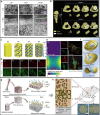Bone targeted nano-drug and nano-delivery
- PMID: 39231955
- PMCID: PMC11375042
- DOI: 10.1038/s41413-024-00356-2
Bone targeted nano-drug and nano-delivery
Abstract
There are currently no targeted delivery systems to satisfactorily treat bone-related disorders. Many clinical drugs consisting of small organic molecules have a short circulation half-life and do not effectively reach the diseased tissue site. This coupled with repeatedly high dose usage that leads to severe side effects. With the advance in nanotechnology, drugs contained within a nano-delivery device or drugs aggregated into nanoparticles (nano-drugs) have shown promises in targeted drug delivery. The ability to design nanoparticles to target bone has attracted many researchers to develop new systems for treating bone related diseases and even repurposing current drug therapies. In this review, we shall summarise the latest progress in this area and present a perspective for future development in the field. We will focus on calcium-based nanoparticle systems that modulate calcium metabolism and consequently, the bone microenvironment to inhibit disease progression (including cancer). We shall also review the bone affinity drug family, bisphosphonates, as both a nano-drug and nano-delivery system for bone targeted therapy. The ability to target and release the drug in a controlled manner at the disease site represents a promising safe therapy to treat bone diseases in the future.
© 2024. The Author(s).
Conflict of interest statement
The authors declare no competing interests.
Figures








References
-
- Bartl, R., Frisch, B., Bartl, R. & Frisch, B. Biology of bone. Osteoporosis: Diagnosis, Prevention, Therapy 7–28 (Springer Berlin Heidelberg, 2009).
-
- Acs, G. & Khurana, J. S. in Essentials of Anatomic Pathology 433–462 (Springer, 2002).
Publication types
MeSH terms
Substances
Grants and funding
LinkOut - more resources
Full Text Sources

